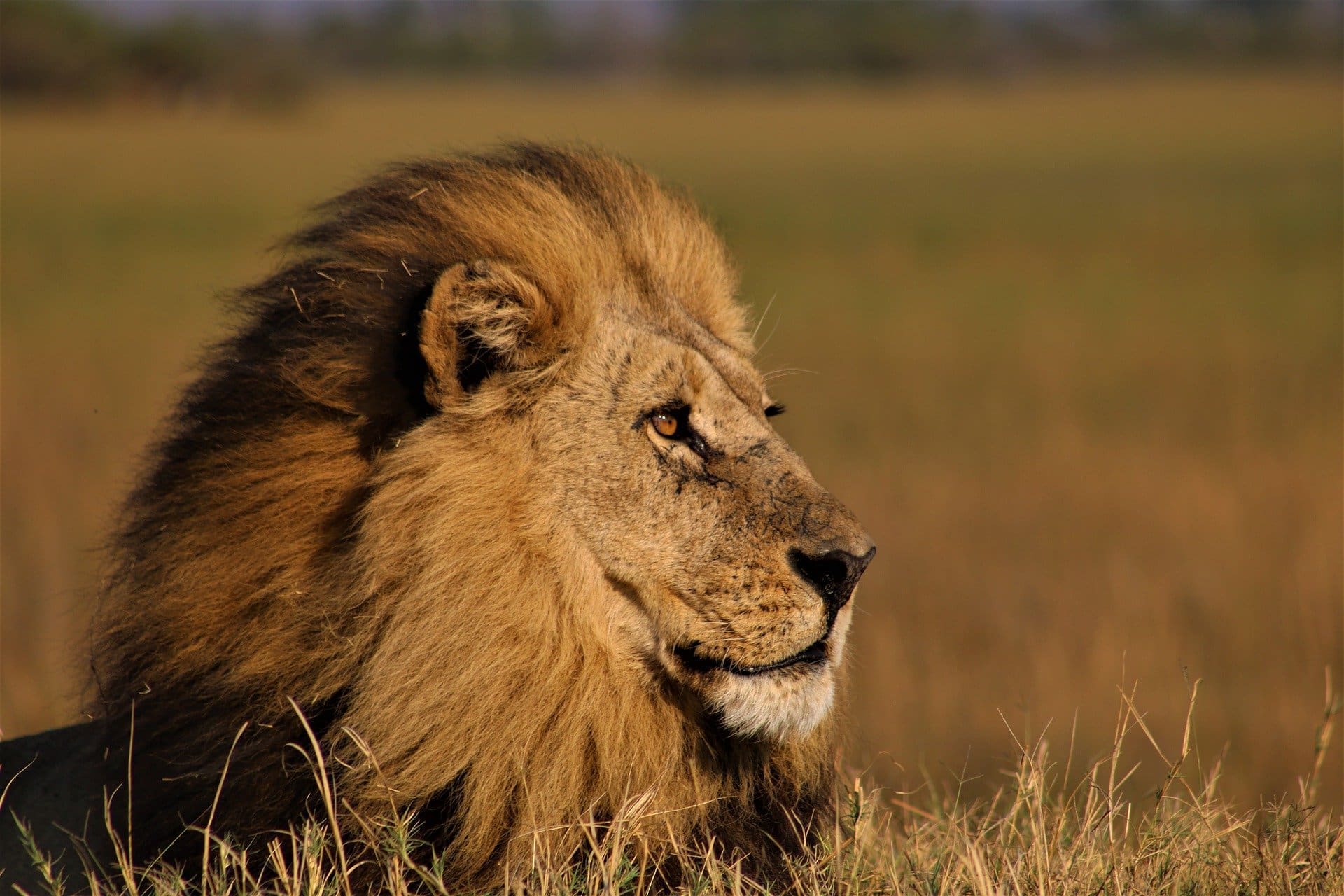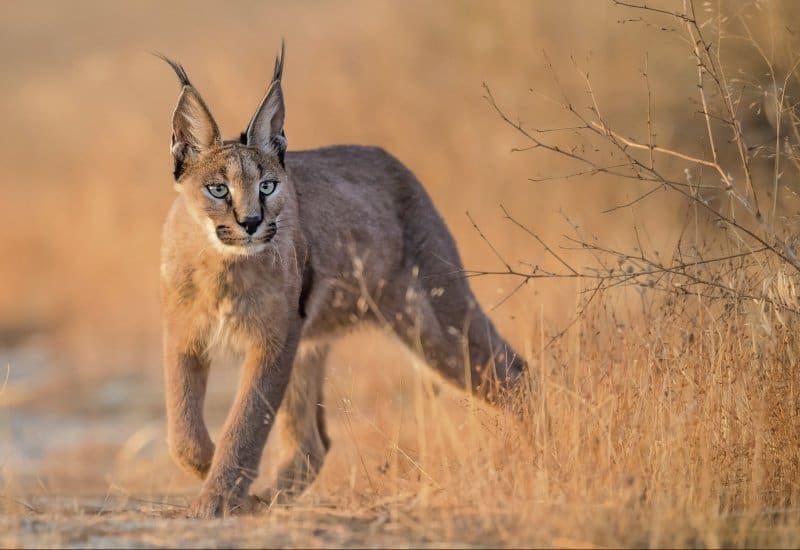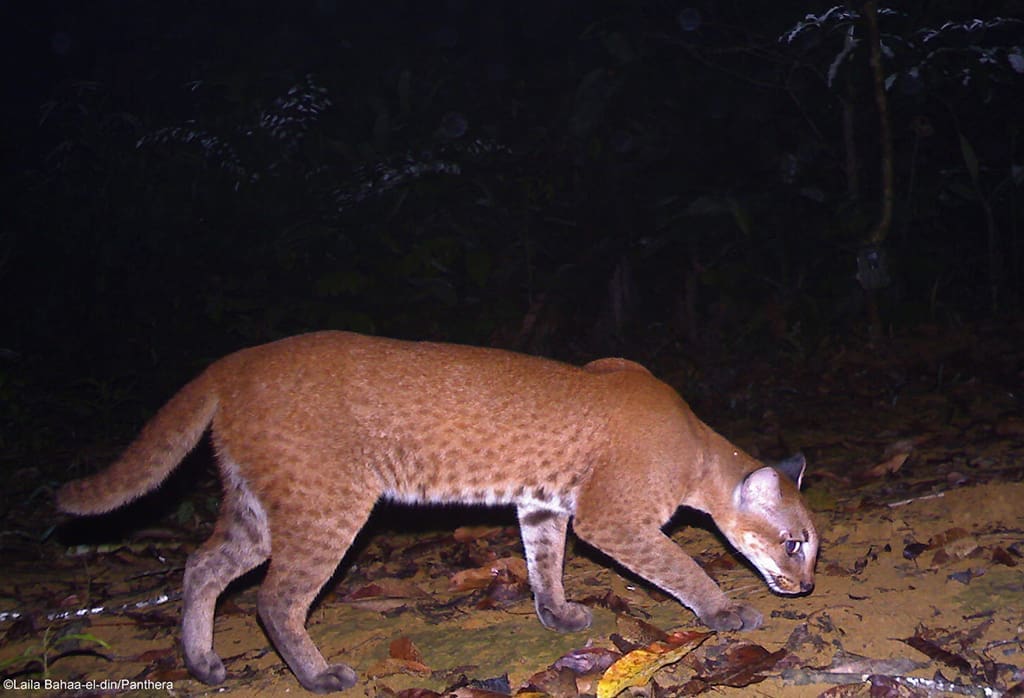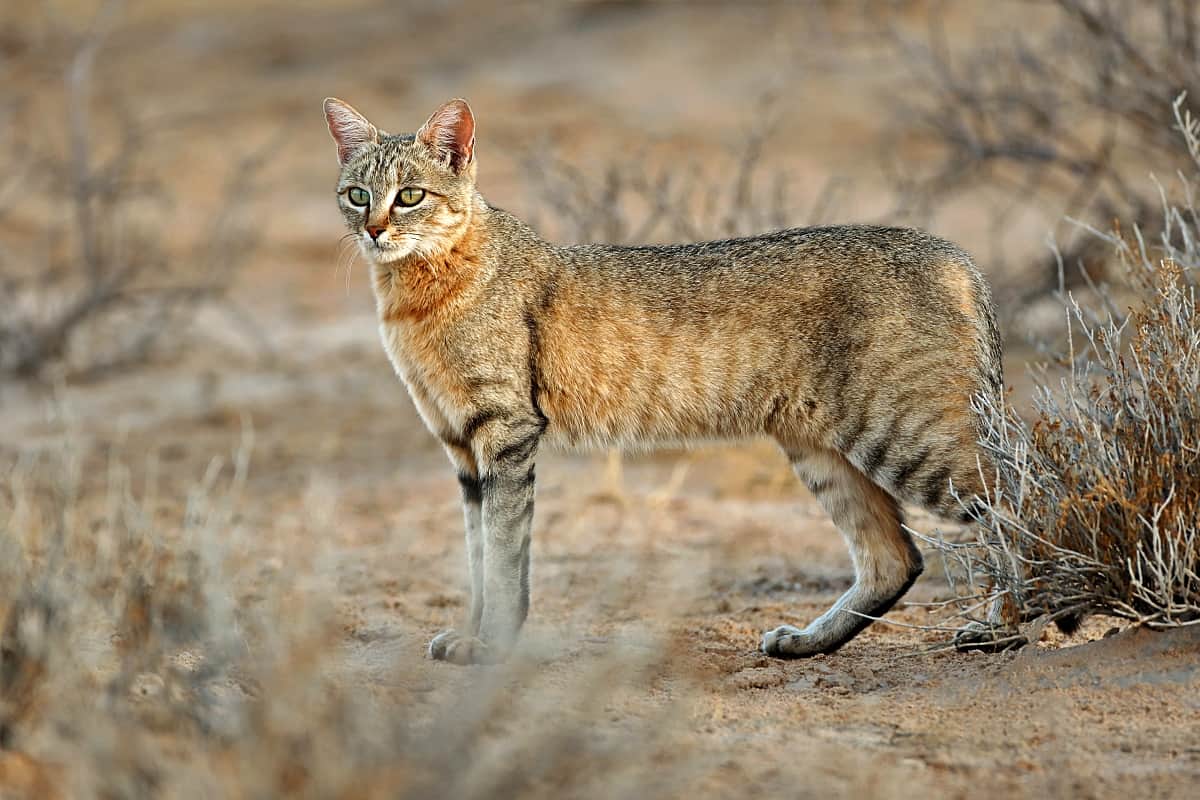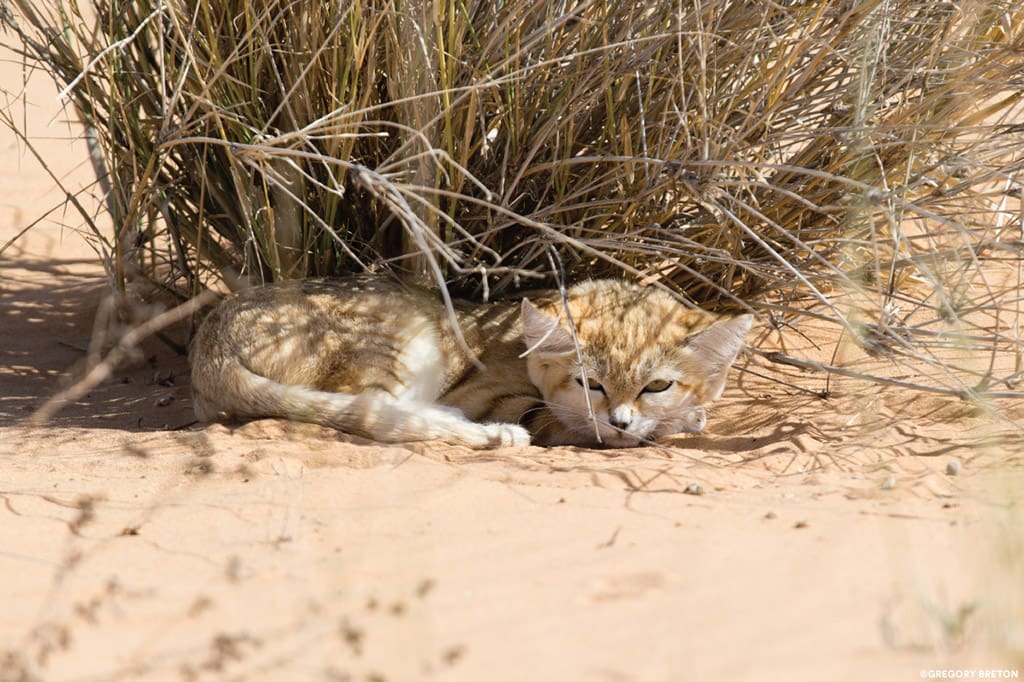Africa is a continent famous for its wildlife and predominantly for the iconic wild cats that draw millions of tourists from around the world, hoping to catch a glimpse of them in the wild.
Unbeknownst to most, there are more than just lions, leopards and cheetahs when it comes to cats. There are actually 7 other species of African cats – all of which are far smaller and seen far less frequently, but equally as beautiful and fascinating!
Here are the 10 species of African cats:
BIG CATS
LION
The African Lion is the world’s second largest cat species, after the tiger – and the largest in Africa. They are a major attraction for tourists and one of the most iconic symbols of the continent.
The undisputed king of the savannah, male lions stand 1.2m (4 ft) tall at the shoulder and can weigh over 200 kilograms (450lbs). These iconic cats are characterised by their majestic manes, highlighted with hues of red, brown and black with some males boasting almost-completely black manes.
Female lions – or lionesses – are slightly smaller in stature, weighing around 130 kilograms (290bs) and don’t grow any form of mane. Unlike African cats, lions are extremely social and are always found in family groups called ‘prides’. The average pride of lions ranges from three to thirty individuals.
Lions are opportunistic predators, which means they will hunt and eat almost anything when the opportunity arises, however their diet primarily consists of large mammals like Zebra, Wildebeest and Buffalo and sometimes even Giraffe. They are ambush hunters, who use their tawny-brown skin colour to blend in with their surroundings.
Trophy hunting, poaching and habitat-loss are the primary contributing factors to the decline in wild lion populations in Africa, and they are currently classified as ‘Vulnerable’ on the IUCN Red List.
LEOPARD
Arguably the most beautiful of the African cat species, the leopard is the most elusive member of the Big 5 and one of the most highly sought after sightings on the continent. Nocturnal by nature, leopards are solitary cats which are usually seen alone except while mating or mother’s with cubs.
The leopard’s intricate pattern is made up of black spots arranged in rosettes, contrasted against a golden-yellow coat. White spots on the tips of their tails and the backs of their ears allow mothers to stand out to their cubs in the long grass.
They are heavy-bodied and powerful cats, able to pull prey heavier than themselves several metres up a tree to avoid scavengers like lions and hyena.
They are exceptional hunters thanks to their variety of skills; the ability to run at speeds of over 56 kilometres (35 miles) and jump over 3 meters (10ft) into the air means they are highly successful predators. They are also excellent swimmers and have been seen wading into shallow pools to hunt catfish. Their diet is varied and prey items include; wildebeest, birds, baboons and even fish, but most times the unfortunate victims are impala.
Game fences are no good for keeping leopards in and they move freely between wildlife reserves and surrounding areas. They are one of the only big game species that can still be found outside of national parks and game reserves.
Habitat-loss for agricultural use means that wild leopards have less space and often face conflict with farmers and rural communities. They are currently listed as Vulnerable on the IUCN Red List.
CHEETAH
The smallest of Africa’s big cats, the Cheetah is a slender and long-legged species that holds the title for the fastest land mammal on earth. These speedy felines can reach top speeds of almost 120km/h at full sprint.
Cheetah are often mistaken for leopards in the wild due to their black-spotted coat, however a cheetah’s spots are smaller and solid, different to the rosettes found on leopards – with a closer look the differences are hard to miss.
Generally cheetahs are a solitary species, but can at times be found in small family groups. This is usually a mother and her cubs or a group of brothers. They spend most of their time frequenting savannah woodland areas and open grasslands, where their preferred prey species also live and feed. The ideal prey for cheetah are small antelope like duiker and springbok, but on occasion family groups will bring down a larger animal such as a wildebeest.
Although they’re equipped with speed unmatched by any other species, cheetahs cannot run at full sprint for longer than a few hundred metres due to the risk of overheating and so they also incorporate elements of stalking into their hunting tactics.
Cheetah are currently listed as ‘Vulnerable’ on the IUCN red list and face a variety of threats including habitat-loss and human conflict.
MEDIUM CATS
CARACAL
The Caracal, one of the medium sized cat species of Africa, is extremely elusive and not often seen in the wild. Known as the ‘rooikat’ or red cat in Afrikaans (a native language of southern Africa) the caracal is found in savannah and woodland areas of sub-Saharan Africa, and sightings are fairly regular in Kruger National Park and the Masai Mara. The caracal can also be found in semi-desert regions throughout the Middle East and the Indian subcontinent.
The largest of Africa’s ‘small’ cat species, the caracal is characterised by a short, tawny red coat with long tufts of black hair on the tips of their ears. The name ‘Caracal’ is actually derived from a Turkish word meaning ‘black ear’. Adult males grow to around 80 centimetres (2.5ft) in length with a shoulder height of between 40 and 50 centimetres.
They are extraordinary hunters with incredible agility, able to climb trees and leap over 3 metres (10 ft) in the air to catch birds in mid-flight. They have also been known to take down small antelope, and will do so when the perfect opportunity arises. However their diet primarily consists of birds, rodents and small mammals.
Caracals are primarily nocturnal which makes them difficult to spot in the bush. Exact numbers in the wild are unknown and caracals are classified as ‘least concern’ on the IUCN Red List, although there are certain regions throughout its natural range where the species is considered to be endangered.
SERVAL
Slightly taller and more slender than their ‘red’ cousins, the Serval is graceful cat found in the open grasslands of southern Africa. There are eighteen known subspecies, with a small population still remaining in Morocco.
Thanks to their intricate black-spotted coat, servals are often mistaken for cheetah at first glance, despite being vastly smaller. In comparison to the big cats, servals are considered as a medium-sized cat, with an average shoulder height of 60 centimetres (2ft) and a weighing around 18kg (39lbs).
The serval’s appearance is characterised by a small head with oversized ears and what are proportionately, the longest legs of any cat species. Their large ears mean they have an exceptional hearing ability, allowing them to point out the tiniest of rustles made by rodents in long grass. They then use their long legs to pounce on their unsuspecting prey from heights of over 2 meters (6.7ft).
The exact size of the total serval population is unknown, but their numbers are believed to be stable, and the IUCN Red List classifies them as being of ‘least concern’.
AFRICAN GOLDEN CAT
The African Golden Cat is a close relative of the Caracal and is endemic to the tropical rainforests of Central and West Africa. These solidly built cats range from the Central African Republic down to Northern Angola. Their coats vary in colour from reddish brown to dark grey and some individuals have spots all over while others tend to only be spotted on their bellies and/or inner legs.
Even among the most knowledgable of wildlife enthusiasts, very few are aware of the existence of the African Golden Cat, and even fewer have been lucky enough to actually see one in the wild.
African Golden Cats were first photographed in the wild in 2002, and very little is known about them in relation to the other wild cat species of Africa. Researchers are currently working on various projects aiming to increase knowledge about the species’ distribution and ecology. As these cats are a very shy and elusive species, hidden camera traps are the most effective way of gaining information about their behaviour.
This medium-sized predator primarily seeks out small prey items such as rodents, tree hyrax and birds but have also been known to hunt small primates, as shown in this camera trap footage caught in Uganda, where an African Golden Cat can be seen hunting a red colobus monkey.
Bushmeat poaching and habitat loss are the main threats facing golden cats and they’re currently classified as ‘vulnerable’ on the IUCN Red List.
SMALL CATS
African Wildcat
A close ancestor of your domestic cat, the African Wildcat is often mistaken for their domestic cousins. Although not easy at first, African Wildcats can be distinguished by their proportionately longer banded legs and reddish ear colouration.
This overall similarity in size, appearance and overall genetic makeup, means that domestic cats are one of the biggest threats to African wildcat populations as interbreeding is extremely common and results in genetic pollution.
The African wildcat has only recently been recognized as a species on its own after originally being classified a subspecies of the European wildcat. The population has not yet been assessed as a species in its own right and when done, we may see a shift from its current IUCN Red List status of ‘least concern’.
Jungle Cat
Sometimes also known as the Reed or Swamp Cat, the Jungle Cat is a long-legged feline characterised by a distinctive white muzzle with large, pointy ears and a sandy-brown coat. Along with the population in Africa, these small cats are widespread throughout the Middle East, China, Southeast Asia and the Indian subcontinent. In Africa they are only found in along Egypt’s Nile Delta.
Contrary to what their name suggests, Jungle Cats actually prefer swamps and wetlands, and are known to actively avoid woodlands and forests. These diurnal predators prey on rodents, birds, reptiles and amphibians that frequent the marshy terrain.
Despite being notoriously difficult to tame, jungle cat mummies have been found in ancient tombs of Egyptian pharaohs, suggesting that they may have once been domesticated and used to help control rodent populations
The jungle cat is currently listed as ‘least concern’ on the IUCN Red List.
Sand Cat
The petite, desert-dwelling Sand Cat is found across North Africa and Southwest/Central Asia. They are the only wild cat species known to inhabit true desert areas and are well-adapted to handle the extremes of the harsh terrain, both from a lack of water point of view and in withstanding substantial temperature fluctuations. The African subspecies is slightly smaller than their Asian cousins and also wears a slightly yellower coat.
The sand cat is a small species with an average shoulder height of 30 centimetres (12 inches) and defining features that include a broad, flat head with short legs and oversized ears.
These large ears house an ear canal about twice the size of that of a domestic cat and their hearing is roughly five times better. This combined with the highest bite force quotient of any wild cat species means the sand cat is an exceptionally successful hunter, generally preying on small rodents and desert dwelling reptiles.
Pale, sandy coloured fur helps the sand cat camouflage perfectly with the desert sand and the undersides of their paws are covered with thick fur that protects against the blazing heat. Sand cats can withstand temperatures ranging from −5 °C to 52 °C, and are known to seek shelter from the weather in burrows made by other animals.
These cats are secretive and very rarely seen, but are listed as of ‘least concern’ on the IUCN Red List.
Black-Footed Cat
The smallest living wild cat species in Africa is the Black-footed Cat, endemic to southern Africa where it is found in semi-arid regions like savannahs, the karoo semi-desert and grassland habitats.
Sometimes also known as the ‘small-spotted cat’ these tiny predators are said to be the most successful hunters of all the cat species of Africa, with an individual being able to consume over 3,000 rodents a year. All this despite growing to a shoulder height of 25 centimetres (10 inches) and weighing less than 2 kilograms (4.5lbs).
The black-footed cat is a stocky built feline with large eyes and rounded ears, and tawny-brown fur dotted with bold black spots. Their diet is mainly made up of rodents, birds and small hares and their method of hunting is a stalk and pounce. Unlike other cat species, they are poor climbers and spend their days sleeping in abandoned burrows made by other animals.
While it is difficult for researchers to estimate the exact number of black-footed cats living in the wild, it is believed that there are less than 10,000 mature individuals and that the population is facing a steady decline. Bushmeat poaching and road traffic accidents are the main threats facing this species, which is currently listed as ‘vulnerable’ on the IUCN Red List.
Where are the best places to see African cats in the wild?
African cats are widespread across wilderness regions of sub-Saharan Africa. Most cats move freely between national parks, game reserves and farm areas, except for lions and cheetahs which are more actively managed. Leopards also fall into this category but cannot be confined within a normal game fence due to their incredible climbing and jumping ability.
Despite this, there a few parks in Africa that are widely renowned for their exceptional sightings of African cats.
These are:
- Londolozi Private Game Reserve, South Africa
- Kruger National Park, South Africa
- Sabi Sands National Park, South Africa
- Maasai Mara National Reserve, Kenya
- Serengeti National Park, Tanzania
- Chobe National Park, Botswana

